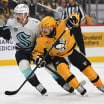Sidney Crosby: An Intimate Portrait (Sid the Man)

COLE HARBOUR, Nova Scotia - People are always asking me if I know Sidney Crosby.
Typically, this occurs after they learn of my position as the director of content for the Pittsburgh Penguins hockey club. Usually, that question is preceded by the question of what my job entails.
After assiduously explaining my duties as a beat reporter who covers the Penguins via website articles, PensTV videos, radio hits on the official broadcast station, videoboard duties and social media (@PensInsideScoop), the question always comes.
"What is Sidney Crosby like?"
It almost never fails. Some ask with coyness, others with bravado. But they all want to know the same thing: "What is Sidney Crosby like?"
It's a simple question with a complex answer. Crosby is a dichotomy of two colliding worlds.
On one hand, Crosby is the most unique individual in the sports world with a rare blend of character, professionalism, talent, skill and work ethic. He's a generational player that has won three Stanley Cup championships, two Olympic gold medals, and - thanks to today's modern media - has reached a level of celebrity and exposure that rivals no other player in hockey history.
On the other hand, Crosby isn't any different from most people growing up in a small town in Canada that loves the sport of hockey. He's grounded, humble, down-to-earth and modest. Crosby spends his off-season summers in his hometown of Cole Harbour, Nova Scotia with his small circle of close friends and family.
It's hard to fathom that the face of an entire league - and an entire sport - is just an everyday guy.
"At the end of the day he's just one of the guys," said Mike Chiasson, a longtime friend of Crosby's. "He just happened to be a lot better at hockey than the rest of us."
I've covered Crosby for nine seasons with the Penguins, from the triumphs of Cup championships and gold medals to the tribulations of concussions and early playoff exits.
So, what is Sidney Crosby like?
On the ice, Crosby is the greatest player of his generation for a reason. It's true that he was blessed with the unique strain of genetics that gives him the predisposition to excel at his sport. But what separates him from his peers isn't just God-given talent.
I've seen firsthand on a day-to-day basis the work he puts into his craft in every aspect, from his training programs to his practice habits to his video studies. It's the attention to those little details that has allowed Crosby to rise as the greatest player of the past decade.
After winning his first Stanley Cup title in 2009, he spent an entire summer working on his shot. The following season he scored 51 goals and won his first (of two) Rocket Richard Trophies as the NHL's goal-scoring champion. The following season Crosby posted 32 goals in 41 games before his season was cut short due to a concussion.
Crosby's faceoff winning percentage was below .500 during his first two seasons in the NHL. So obviously, he began to devote time following every practice to work on his draws. In his last 10 years in the NHL Crosby has averaged 55.6 percent.
Crosby's professionalism on the ice bleeds over into the locker room, where he patiently deals with the media barrage on a daily basis, sometimes even twice a day. He always faces the media, even during losses or tough stretches. Crosby is polite with reporters and respectful of their jobs.
Off the ice, Crosby is everything that you've heard, and probably more. He is genuine, unassuming, thoughtful and passionate. Crosby treats everyone around him with dignity and respect - whether you're a media member, the general manager, a fan seeking an autograph or even just a maintenance worker at the arena.
The way Crosby treats people probably says more about him than anything else. And I can personally speak to that treatment (more on that later). But to really get a sense of who Crosby is, I went right to the source.
I spent a few days in Crosby's hometown of Cole Harbour, Nova Scotia during his annual Hockey School, which is held at Cole Harbour Place, where he played his youth hockey. During that time I had a chance to spend some time with Crosby's closest friends and family to get a closer look at Sidney Crosby the man, and not just Sidney Crosby the hockey player.
That experience inspired the recent "Intimate Portrait" series, which you are reading right now (so meta). During that series we've taken a look at Crosby through the eyes of his sister, Taylor, his former youth hockey coach and longtime family friend, Paul Mason, his best friends and even the community as a whole.
All just to answer that never ending question: "What is Sidney Crosby like?"

Sid the Kid
Modern psychology teaches that a person's personality is fully developed by the age of 7. The experiences and nurturing we receive at a young age plays a major role in how we mature as adults.
With Sidney Crosby, it's hard to differentiate between his on-ice and off-ice traits. After all, the same passions and ambitions that defined his childhood are what also defined his hockey career.
Crosby's workmanlike attitude was born out of his upbringing in the small Canadian town of Cole Harbour. The suburb of roughly 25,000 residents is dwarfed by the nearby cities of Halifax and Dartmouth, but has a proud and strong-willed citizenry.
Crosby was born on August 7, 1987 - hence the reason he wears No. 87 - and already had hockey in his blood. His father, Troy, was drafted by the Montreal Canadiens in the 12th round of the 1984 NHL Draft. Although Troy, a goaltender, never played in the NHL, he did plant the passion for the game into both of his children.
Crosby's love for hockey started when he first put on a pair of skates at the tender age of 2. Troy and Sidney's mother, Trina, placed a regulation-size net in the family's basement so Sidney could practice his shot - though ironically he's never shot against his netminding father.
"We would have sleepovers at his old spot, Trina making pancakes in the morning," said Matthew Foston, Crosby's close friend for the past 25 years. "It was a pretty cool basement that they had setup for him. He was firing pucks every single day. He made the most of it to get the shot he has today."
Although he was like any typical kid in his youth, there was something special about Crosby. While the other kids would sleep in during the summer months, Crosby would wake early and eagerly pester his friends to play street hockey or go mini-golfing. Even at a young age, Crosby possessed a competitive spirit that most kids couldn't fathom.
"The guy just wanted to get up and get on the rollerblades, meet somewhere and play road hockey. He was always looking to set up a game," said Mike Chiasson, who has been friends with Crosby since playing Timbits hockey together.
"He hasn't changed from the time he was 6 or 7. Whether it's mini-putt or road hockey, it's always a series or championship on the line. I guess that's why he is where he is today."
Perhaps that's why the two-time Conn Smythe winner as NHL playoff MVP has such a flair for the dramatic and delivering in the clutch. More so than even his natural talent, it was that inner drive, unmatched among his peers, that helped Crosby rise quickly in the youth hockey ranks.
"Sid is very, very competitive," said Mason, who has coached Pee Wee hockey in Cole Harbour for 39 years. "He had a drive to learn and a will to win that you don't see in kids that age. He hated to lose probably more than he liked to win."
Those intangibles allowed Crosby to play against kids that were two or three years older. And his hockey intelligence allowed him to not only compete against older kids, but to dominate the field.
"We said it jokingly, but we weren't joking," recalled Mason, who coached Crosby from ages 10-12, "offensively you almost couldn't coach him at Pee Wee because he saw things that you didn't see."
Even today, Crosby is a student of the game: its history, its strategy, its evolution. He sincerely enjoys talking about any aspect of hockey. It's literally his life. That seed was also planted in his youth.
"He was always younger and would be a listener and always watching what guys were doing," said Jeff Kielbratowski, who played Midget hockey with Crosby. "He always wanted to be involved in stuff. Even if he was younger, he still wanted to be a part of everything."
Kielbratowski was 16 years old when the 13-year-old Crosby joined his team. Kielbratowski, the team's captain, wanted to make sure that his younger teammate was involved and wasn't overwhelmed.
"In the end we wanted to look out for him," said Kielbratowski, who has remained close friends with Crosby. "The fact that he was 13 and playing with 16- and 17-year-olds, you want the best for your teammates, but also since he was so much younger we wanted to take care of him."
Crosby had been a hockey phenomenon since the age of 5. The hype surrounding his rising star would only grow with his age.
"As he started to mature and became a teenager, became a man, he just went leaps and bounds above everyone," Kielbratowski said. "He went lights out in his first year at Midget as a 13-year-old. It was pretty evident that he was going to be an elite player."
Crosby would make stops at the prestigious hockey prep school Shattuck-St. Mary's in Faribault, Minnesota, winning a USA national title, and Rimouski of the Quebec Major Junior Hockey League for his junior career. Crosby torched the stat sheets at both stops while garnering the nickname "Sid the Kid."
It was pretty clear, even at 17 years old, that Crosby would be a once-a-generation player. After a labor dispute wiped out the 2004-05 season, a lottery was held to determine the selection order of the 2005 NHL Draft, dubbed the "Sidney Crosby Sweepstakes."
The Penguins organization won the lottery and the right to draft Crosby. The fate of a storied franchise was placed in the hands of an 18-year-old prodigy. Crosby handled the pressure of an entire city and franchise with his usual aplomb and courage. It was Ernest Hemingway who wrote, "Courage is grace under pressure."
During 12 NHL seasons, Crosby fulfilled his immense promise by delivering three championships while saving the fragile franchise from bankruptcy and relocation to usher in the greatest era of success for the Penguins both on and off the ice. "Sid the Kid" has grown up and already built a legacy as one of the greatest players to ever play the game.
And he achieved all of that before turning 30 years old.
Sid the Man
On August 7th, Crosby will celebrate his 30th birthday, and he'll be celebrating in style.
Crosby is spending his birthday with the Stanley Cup and 60,000 fellow Nova Scotia natives at the Natal Day Parade, which - ironically or perhaps appropriately - celebrates the birthday of the city of Halifax. The native son will be the grand marshal of the parade.
It's only fitting that Crosby bring the Stanley Cup home. That's what Cole Harbour is to Crosby. Home. Even after all these years.
Crosby built his permanent residence in Cole Harbour and his parents still live in the same house in which Sidney shot thousands of pucks in the basement. Every off-season Crosby returns home to spend his summers surrounded by friends and family.
"He'll never forget where he came from. He looks forward to getting home every summer," Chiasson said. "He's proud of where he's from."
"I think he just feels comfortable being around the people he grew up with," Foston said. "We treat him the same. We give him the gears if we have to and he gives us the gears."
Crosby's love of his roots is a source of pride among to locals in this small town.
"He's like the rest of us. We're Maritimers," said 62-year-old Robert Bird of Amherst, Nova Scotia. "I have friends that are away for 10 years, but when they come back they say they're going home. Sid has that in him, the small town, small Province, humble upbringing. It means a lot to us here that he remembers his roots."
"It didn't all go to his head," said 60-year-old Jerry Thibeault of Cole Harbour. "He still calls this home. He still comes back here. It's certainly clear that he is the best (player). It's nice to see somebody remember."
You would be hard pressed to find anyone with a negative comment about Crosby in Nova Scotia.
"You hear all these stories of how he interacts with people in the community," said 42-year-old Keith McNamara of Halifax. "He's very gracious for autographs. It shows the type of person that he is. He is a strong, family guy. He's got a great network of friends. Sometimes that foundation starts from when you're born."
The foundation was certainly built from Crosby's youth. But if you ask any of his closest friends and family, the foundation hasn't changed much in the past quarter century.
"The fun thing about Sid is that nothing has changed," Chiasson said. "He's the same guy that he was years ago. He's a down-to-earth guy. How he comes across is exactly how he was growing up."
"If you ask anyone about him all you'll hear are good things," Kielbratowski said. "He's just a character guy. He has good values. He comes from a great family. He's never changed the person that he is. It's good to see that with a guy that's had as much success as he's had."

It's almost paradoxical that the face and highest profiled player of an entire sport prefers to keep a low profile. Crosby doesn't seek out attention, regardless of how much the spotlight seeks him out.
"He's a pretty private, quiet guy," Foston said. "When he's around his friends he seems to open up a lot more and be a lot more comfortable."
Crosby's actions in the community also speak volumes about the man that he is. He established the Sidney Crosby Foundation, which recently donated $50,000 to KidSport Nova Scotia to help kids participate in a variety of sports. His annual Sidney Crosby Hockey School is held in his youth rink of Cole Harbour Place. All of the money and proceeds are given to various partners and charities.
"Everything he does tells you who he is," Thibeault said. "He gives all the money away. There are not a lot of people that would do that. You can't help but admire the guy. Everybody in Cole Harbour appreciates what he's doing."
Crosby held his Hockey School from July 10-14. As with every year, he was very hands-on, taking part in on-ice sessions, signing autographs and making sure he had some quality time with every kid.
"He has such a big heart," said Raelene Bird, whose grandson MacKenzie Paris, 10, participated in the camp. "Even on the ice, he's outstanding with the children, talking with them, joking with them. You can tell he genuinely enjoys it."
Crosby used to be one of those youth hockey players: wide-eyed, buzzing around the ice at Cole Harbour Place, dreaming about playing the NHL. But even when Crosby was just a youngster, he still had a maturity that was well beyond his years. Even his sister, Taylor, called him an "old soul."
Perhaps that's why Crosby was always able to fit in while playing against players that were older. That maturity served him well when he became the youngest captain in NHL history (since surpassed) at just 19 years old. He also became the youngest captain in NHL history (21 years old) to win a Cup in 2009.
Crosby is a natural leader and always goes out of his way to make sure everyone in the Penguins locker room feels welcome and comfortable. The first text Ryan Reaves received after he was acquired by Pittsburgh during the NHL Draft a month ago was from Crosby. He also helped Carl Hagelin find housing when he was traded from Anaheim in January of 2016. When rookie Jake Guentzel made his NHL debut, Crosby asked for their locker stalls to be next to each other.
"Everybody knows how superstitious Sid is about his whole pregame routine, so I'm just trying to stay as far away from his area as possible so I don't accidently knock over anything or get in his way," Guentzel wrote in the Players' Tribune. "But honestly, Sid was just the nicest guy right away. He said, 'Hey, you're here now, so you might as well have fun with it, eh?'"
If I've learned anything from covering Sidney Crosby over the past decade it's that he, more so than any other person I've met, "gets it." He is a warm and welcoming soul. An "old soul," as Taylor eloquently put it.
Personally, my favorite memory with Crosby occurred in the Penguins locker room following their Game 6 Stanley Cup victory in San Jose. The entire team is celebrating. Champagne is flowing and everyone is singing and cheering. The Penguins had overcome an ugly start to the season, but defied the adversity to finish the year as the league's champions.
And at the center of it all was Crosby. He's holding the cup, filling it with libations and tipping it so that everyone in the room can taste the liquid from the Cup. I was standing off to the side, trying to take in the experience, but not wanting to interfere either - the players earned this, I was simply along for the ride.
Crosby spotted me in the corner and yelled for me. His head beckoned me. I obliged. He tilted the holiest chalice in hockey and I fulfilled a lifelong dream.
That's what makes Crosby so special. He wants everyone to feel included, from the coaches to the staff to the team chef. Crosby wants everyone to be a part of it. Even in a moment like that, surrounded by madness, Crosby had the presence of mind to make sure everyone drank from the Cup and enjoyed the spoils of victory. His selflessness knows no bounds. That's the Sidney Crosby I know.
So what else did I learn about Crosby during my time in Cole Harbour? Just more of what I already knew - that as highly regarded as Crosby is as a hockey player, it pales in comparison to Crosby as a person. Everything you hear said about him - grounded, humble, down-to-earth, modest - it's all true.
"He's someone who has good, strong family values," said Mason, a friend of the family for two decades. "That's something he was taught, but continues to maintain even after the fame and fortune."
So what do I tell people when they ask: "What is Sidney Crosby like?"
I just say, "He is the best."
And leave it at that.



















































